
The payara fish, also known as the Dracula Fish, is one fish with teeth on our list of eight.
On many occasions, I’ve gotten distracted while fighting a fish, and when I finally had my quarry close enough to land, I quickly reached down and grabbed it by the lip to bring it in the boat. If it’s a largemouth I’m landing, or a big crappie or striper, that’s not a problem. When fishing in some waters, however, the creature that gets grabbed may grab back. And if it’s one of the toothy terrors listed here, it could leave you with wounds that need stitching, or worse.
I, therefore, warn you to think twice before lipping the next fish you bring alongside your boat. In the Western Hemisphere, rivers, lakes and saltwater environs are home to many fish that have maws studded with rows of needle-sharp teeth. If you make a mistake and grab one of these bad boys by the lower jaw, you may find yourself heading to an emergency room.
Beware these bad-to-the-bone beasts that bite!
Table of Contents
1. Payara

They don’t call it “Dracula fish” for nothing. This South American favorite has the countenance of a vampire, with two fangs as long as your little fingers erupting from its lower jaw—plus dozens of other sharp teeth. With needle-sharp tips and knifelike edges, these dentures are perfect for impaling the payara’s favorite dinner: live piranhas. And you know any fish that eats piranhas must be one tough customer.
While fishing for payara on the Rio Paragua in Venezuela, we often reeled in piranha baits so full of holes they looked like hamburger meat—the result of payara attacks. The fish’s long lower fangs fit nicely into sheaths in the upper jaw, but the payara’s strike is as swift as a cobra. It can open wide and impale you before you know it happened. The result is guaranteed to be extremely bloody and painful.
2. Alligator Gar
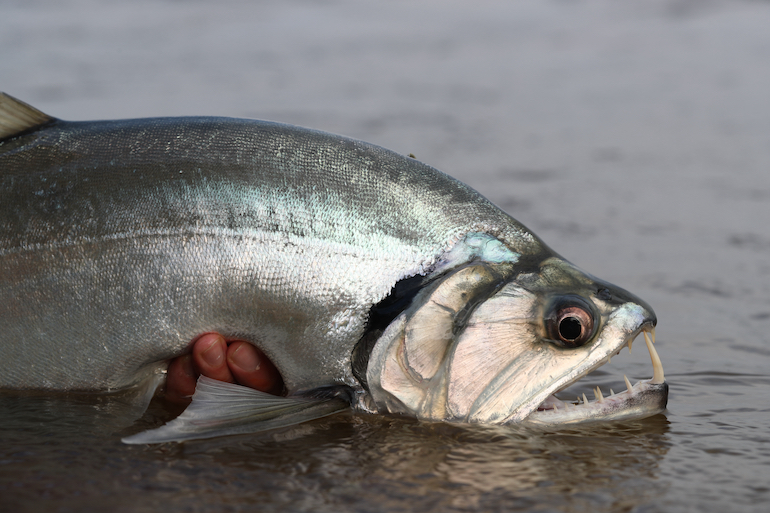
The alligator gar is a toothy, armored-covered leviathan of Southern lakes and rivers. Its size impresses—sometimes more than 8 feet and 300 pounds. Looking into one’s tooth-studded maw is like staring death in the eye.
John Fox guided for Arkansas gator gars in the 1950s. He tells the story of one client so horrified by the hellish stare of a gar that jumped near the boat, he deep-sixed Fox’s rod and reel, with the gar still hooked, and demanded to be taken immediately to shore.
“A guy fishing with us one day let one jump in the boat,” Fox said. “It tore the side of the boat out and broke the man’s leg!” Nineteenth-century news accounts describe many instances of persons being killed or injured by these fish, including people snatched off houseboats.
If you mess with this bad boy, be sure your life insurance is paid up.
3. Bowfin

At first glance, the bowfin looks pretty harmless. Its teeth, which are immovable outgrowths of its jawbones, aren’t readily apparent. But if you examine a bowfin’s mouth up close—if you’re stupid enough—you’ll get the definite impression that, given a chance, it would chew your arm off, and if it were the size of an alligator, people wouldn’t be safe in the water. Nicknames include mudfish, dogfish and grinnel, but more vulgar monikers often are used by frazzled fishermen with broken lines, mauled lures and shattered poles.
Writer Jim Spencer gave a vivid account of one bowfin encounter. “It was possibly the most violent strike I’ll ever see in my life, regardless of the species,” he said. “No white marlin ever slashed a trolled skipjack any harder than when that grinnel hit my fast-moving spinner. The water around the lure erupted like a miniature volcano … I set the hook purely out of fright.”
Don’t land one with a lip-lock. If you do, there’s a good probability you’ll come away minus some digits.
4. Esox

Members of the genus Esox—the pike, pickerels and muskellunge—are deadly predators that will kill and eat darn near anything, including squirrels, ducks, young muskrats and sizeable fish. Their long canine teeth, which ring the wide lower jaw, and the short, sharp teeth on the tongue and roof of the mouth, spell instant death to unwary prey. That same dentition can lay open a person’s foot or hand dangled in the water, as has often happened in places where big muskies and pike thrive.
Suffice it to say that putting any body part too near the jaws of one of these marauders can spell trouble if the fish decides to latch on. Extreme caution is advised.
5. Lingcod
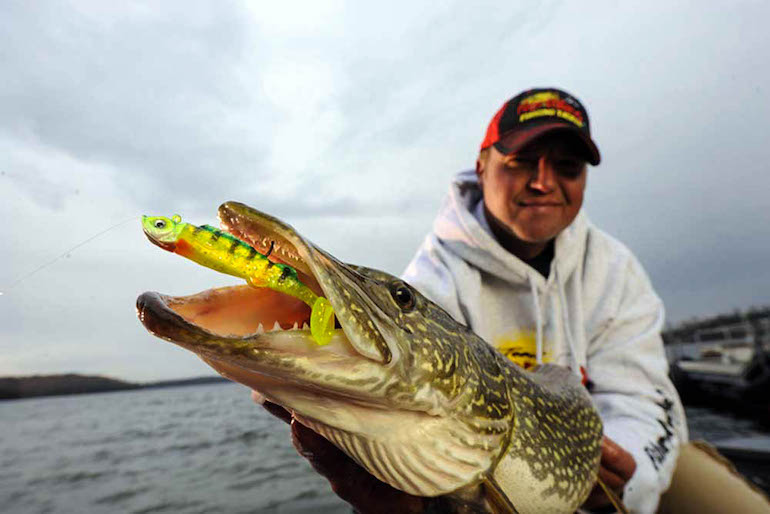
Many saltwater fish are armed with mouths full of sharp teeth, too. Consider the lingcod, whose toothy maw resembles that of a sci-fi monster destined to eat the entire crew of a spaceship. This fish is covered with brownish-red blotches that make it look like it has some kind of skin disorder. Maybe that’s what makes it so ornery. A 40-pounder I hooked off Seward, Alaska slammed me into the gunwale so hard I had bruises for weeks. Pity the person who hooks a really big one, which could top 80 pounds.
You’ll find lingcod year-round in West Coast waters from southern California to the Gulf of Alaska. They’re aggressive and easy to catch on jigs and cutbaits fished around rock piles and reefs. If you’re tough enough to handle one, and it doesn’t snap your line, steer clear of the huge, gaping mouth studded with big teeth. The species’ scientific name, Ophiodon elongatus, means “long snake tooth,” an appropriate appellation.
6. Bluefish
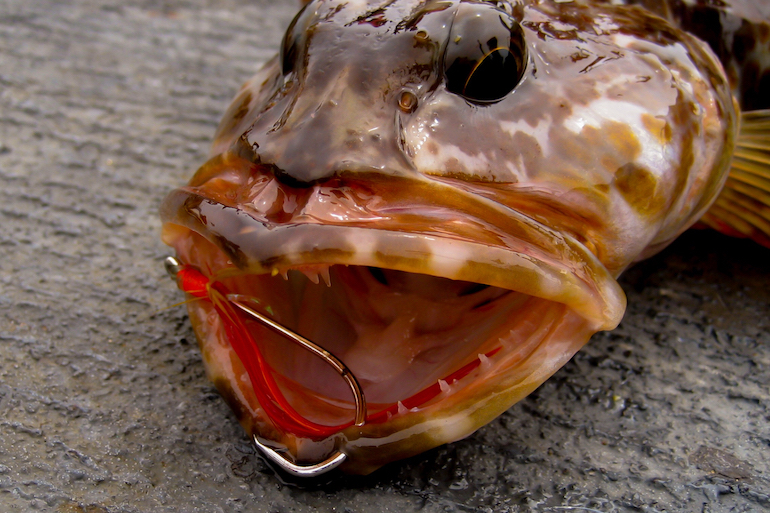
Bluefish are abundant and popular sportfish in many areas, particularly along the Northeast coast. Lots of folks like catching them, but novices may not realize these sleek, powerful marine fish pack a dangerous set of dentures. I’ve seen them bite right through a hook, and saw a fellow angler lose part of a toe to one that dropped thrashing in the bottom of our boat.
Schools of bluefish often “blitz,” pushing baitfish near shore as they feed on them. Swimmers, surfers and others in the water sometimes suffer serious bites if they’re unfortunate enough to get caught in the feeding frenzy. If you handle one carelessly while fishing, there’s a definite risk it could remove some big chunks of flesh from any body part that gets near those chomping jaws.
7. Black Piranha
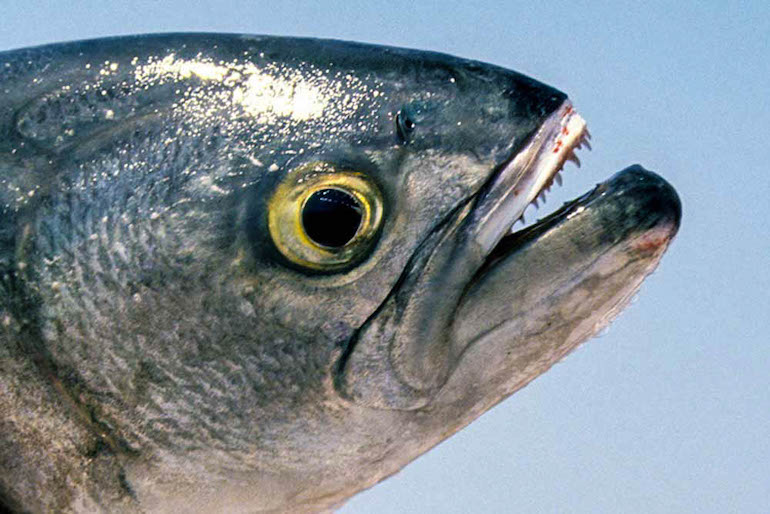
“They are the most ferocious fish in the world,” Theodore Roosevelt wrote of piranhas. “They will rend and devour alive any wounded man or beast.” Mean doesn’t begin to describe them.
Most of the 17 species in South American waters are beautiful fishes, but not so the black piranha. The biggest of its clan, weighing as much as 13 pounds, this purplish flesh-eater looks like the embodiment of pure evil, with blood-red eyes and a jutting jaw lined with razor-edged teeth. A fearsome 5-pound specimen in Brazil exploded on a big prop bait I cast, sending a spray of water high into the air. When I lifted the fish over the gunwale, it bit cleanly through the 3/0 treble hook impaled in its jaw. They’ve been known to take off fingers and toes with equal ease.
8. Wolf Fish
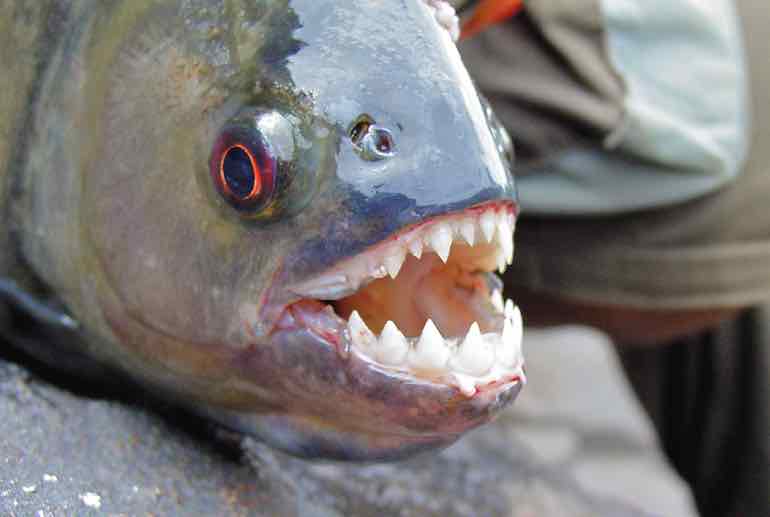
Brazil’s giant trahira, or wolf fish, looks like something that should be chasing Sigourney Weaver around a spaceship. This little-known fish weighs up to 50 pounds and has chompers that look like they could bite through nails. Think “nuclear walleye” and you’ll have a good picture.
When hooked, this evil-looking primitive does a tarpon-on-steroids impersonation, jumping repeatedly. You’ll need heavy tackle to drag it out of the snag-filled jungle backwaters it typically inhabits, but chances are, even that won’t survive a brutal battle with one of these raging bulls.
Don’t hold a trahira near any body part you want to keep. They’ve been known to rip chunks of flesh from nitwits wading barefoot in shorts.








































